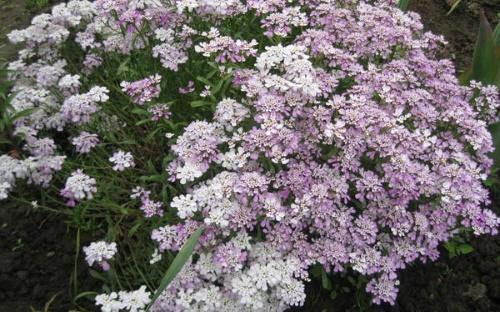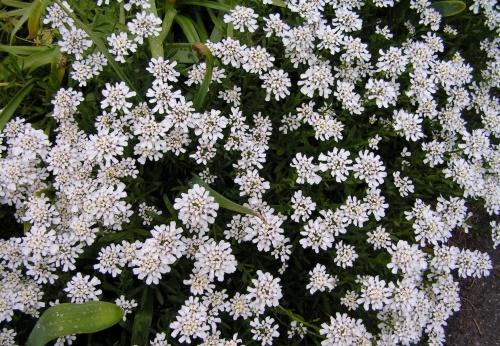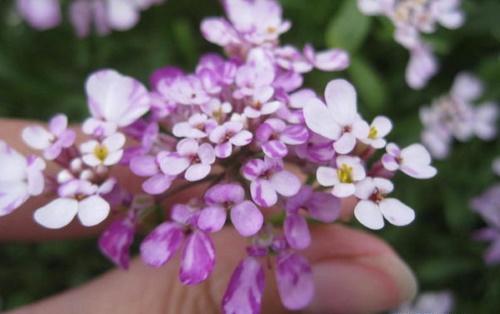Iberis Gibraltarian chameleon - blooming and fragrant "pillow" in your flower bed
 Among the "fragrant" plants for a flower bed, not only matthiola with its breathtaking scent is especially popular. The Gibraltar chameleon, one of the most unpretentious cultures, will delight you with fragrant flowers and Iberis. And although its flowers are small, besides the aroma, they have one more original feature. At the beginning of flowering, they are the same color, and after a couple of weeks they begin to darken rapidly, acquiring a rich, bright color. Even a novice gardener can grow Iberis. This plant is unpretentious and not demanding to care for. Moreover, it reproduces well by self-seeding. Once sowing seeds, you can admire the flowering of Iberis for many years.
Among the "fragrant" plants for a flower bed, not only matthiola with its breathtaking scent is especially popular. The Gibraltar chameleon, one of the most unpretentious cultures, will delight you with fragrant flowers and Iberis. And although its flowers are small, besides the aroma, they have one more original feature. At the beginning of flowering, they are the same color, and after a couple of weeks they begin to darken rapidly, acquiring a rich, bright color. Even a novice gardener can grow Iberis. This plant is unpretentious and not demanding to care for. Moreover, it reproduces well by self-seeding. Once sowing seeds, you can admire the flowering of Iberis for many years.
Iberis Gibraltarian chameleon

Iberis looks beautiful, planted in the foreground of flower beds or along the border.
Thin, but strong enough stems of the plant are highly branched and densely covered with narrow light green foliage. The leaf plate is elongated and expands towards the end, forming a resemblance of a drop with a slightly serrated edge. Both shoots and leaves are weakly pubescent.
 But the main advantage of the Gibraltar Iberis is flowering. It begins at the end of spring and for a whole month and a half the bush turns out to be strewn with small flowers. At first they are snow-white, but after a while, crimson-pink stripes begin to appear on the petals. It is for this that the Iberis was nicknamed the chameleon. The flowers themselves are of an original shape, with petals of different sizes, and form dense umbellate inflorescences.
But the main advantage of the Gibraltar Iberis is flowering. It begins at the end of spring and for a whole month and a half the bush turns out to be strewn with small flowers. At first they are snow-white, but after a while, crimson-pink stripes begin to appear on the petals. It is for this that the Iberis was nicknamed the chameleon. The flowers themselves are of an original shape, with petals of different sizes, and form dense umbellate inflorescences.
The Gibraltar Iberis is considered a perennial, but quite often in our climate it grows as a biennial. In the first year of planting, the bushes increase the deciduous mass, and bloom only in the second year of life. By autumn, the stems dry up, however, having managed to give seeds. They crumble into the soil and in the third spring the Iberis rises again.
Agrotechnology for growing Iberis in the garden
 Like all abundantly flowering plants, Iberis will bloom more luxuriantly in a sunny place. He is not particularly picky about the soil, the main thing is that it is not sour and waterlogged. Feels good on an alpine hill, among the stones. You can plant in open ground (in spring or before winter) or by sowing seeds on seedlings.
Like all abundantly flowering plants, Iberis will bloom more luxuriantly in a sunny place. He is not particularly picky about the soil, the main thing is that it is not sour and waterlogged. Feels good on an alpine hill, among the stones. You can plant in open ground (in spring or before winter) or by sowing seeds on seedlings.
In leaving, Iberis is practically not picky, just enough:
- weed the flower bed and loosen the soil;
- water periodically, especially in dry summer;
- cover the bush with spruce branches for the winter if it is very cold and with little snow.
Fragrant flowering bushes may well do without top dressing. But the introduction of the mineral complex, at least during the period of bud formation, will only go into his hands, increasing the number of flowers.